Isms Understanding Modern Art on Early 20th Century Art
There is no doubt that the 20th century art was all about changing perspective. The artist'southward way of seeing and therefore agreement things has been irresolute and continues to do so fifty-fifty in this day and age. The new, experimental approach to perspective was pursued both directly and implicitly. Painters and sculptors had abased linear perspective and began discovering other ways of representing reality, but furthermore, the very vantage point from which to observe and encompass fine art in full general was changed too. It was art's way of breaking with tradition and embracing a different approach to its disciplinarity, on the 1 hand, and reality on the other. This radical shift was not simply present in the art world, of form. Rather, it was similarly embodied through other aspects of our lodge - economics, industry and social unrest. To all of this, fine art was never blind, which is why it was always continued to life, fifty-fifty when it claimed (and gained) independence.
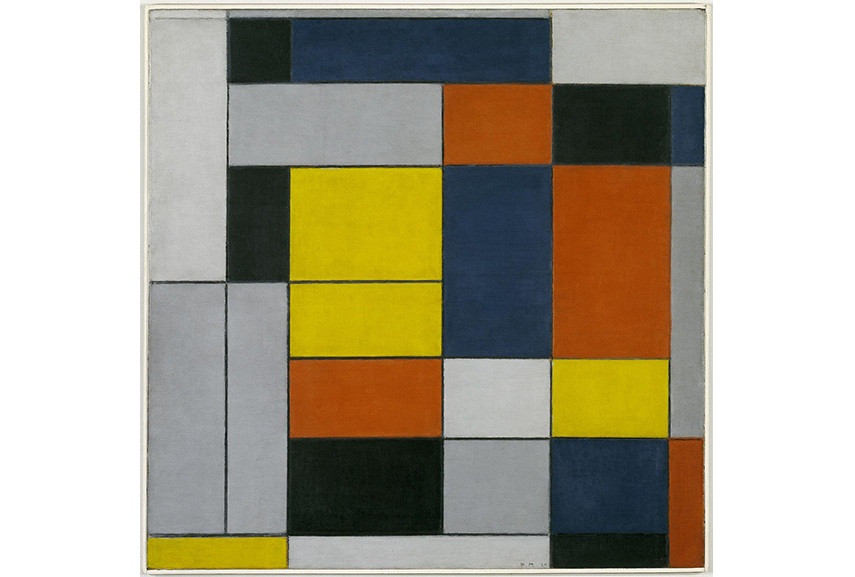
Introducing Modernistic Art
Dissimilar theorists translate different movements as predecessors of mod art; and modernism is what we recognize as the historical theme of the 20th century today. This is mostly due to various understandings of what modern art entails, since this wide category has been changing its meaning throughout history. In sum, nosotros have to thank Realism for changing the nature of discipline thing, and I mpressionism, as well as Mail service-Impressionism, for building upon this idea and introducing subjectivity and selective layers of representation. These 2 movements triggered a series of responses that came in the post-obit years.
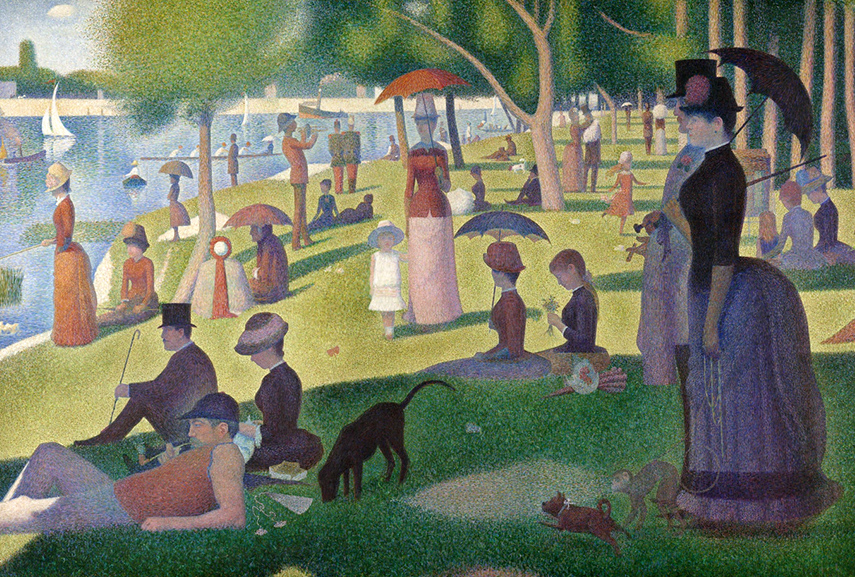
Fauvism in France
The first new style that emerged in the 20th century was the rebellious, anti-rational, colorful Fauvism . Iii of its nearly notable protagonists (Henri Matisse, Andre Derain and Maurice de Vlaminck) met, symbolically, in the 1st yr of the century (1901) and that was when they decided to share a studio. Their collaboration somewhen led to a new approach in painting, which, although short-lived, had immense impact on other styles and resonated over the form of decades. The group adopted the name "Wild Beasts", which was initially used by the famous fine art critic Louis Vauxcelles and intended as an insult. Hence the proper noun of this inconsistent movement - Fauvism. The Fauves introduced individualism, using dumbo brush strokes and dissolving the forms, which led to a very evident "alter of perspective" mentioned in the starting time. The members went carve up ways before their style turned into mannerism.

Expressionism in Germany
While the beasts were raging in French republic, there began a like modernist movement in Germany. These 2 painterly styles shared numerous characteristics, amidst them a crucial emphasis on cocky-expression, color and the emotion that it relates to. They both favored subjectivity over realistic delineation and the painters used quite like techniques to achieve this. Expressionism was, withal, established later in 1913, fifty-fifty though it coexisted with fauvism in the past. This fabricated it difficult for Expressionism to larn significance as a move, since it coincided with many other -isms and devastating events (such as Earth War I), during which information technology was urgent for fine art to accept on a more political, more critical function. Nonetheless, many expressionists, such every bit Kandinsky and Klee, are certainly among the most famous painters ever.
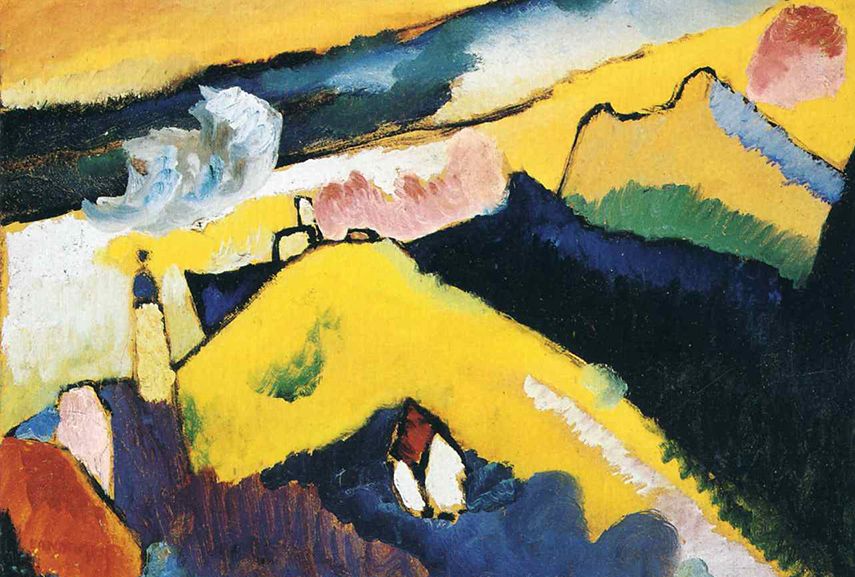
Cubism - The Very Explicit Change in Perspective
In the 1910s, Cubism made us re-think what we already knew - that our world is not two-dimensional. It did so in an unlikely manner, by aligning unlike views of bodies in space ane next to another, thus making the flatness attest to the multiplicity of our world. In their paintings, Picasso, Braque and Gris constitute new ways to simultaneously correspond different facets of objects, humans and landscapes, creating a familiar distorted type of imagery of which many are in awe, even today. Information technology affected sculpture and architecture, and even survived the First World War. However, afterward 1918, cubist paintings have already become part of a more than conservative stream, since painting itself was facing a critical point, later which many questioned its role and fifty-fifty existence in the future.

Futurism - Capturing Motion
Visually similar but ideologically controversial, Futurism arose in Italian republic shortly after Cubism in France. In painting and sculpture, Futurism was in much inspired past Cubism as a fashion. It, too, aimed to represent the multifaceted picture that embraces more than than 1 single outlook, often depicting multiple postures in a single piece. However, most Futurists were driven past a clearly defined manifesto, with their ideological guidelines rooted in nationalism, industrial revolution, speed and the triumph of technology over nature. Because of this admiration for the progressing, modern era, many Futurists strove to support Fascism, every bit they believed information technology fought for the same cause. Connection with the Fascist Party cast a night shadow over many futurists after World War II was over.[i]
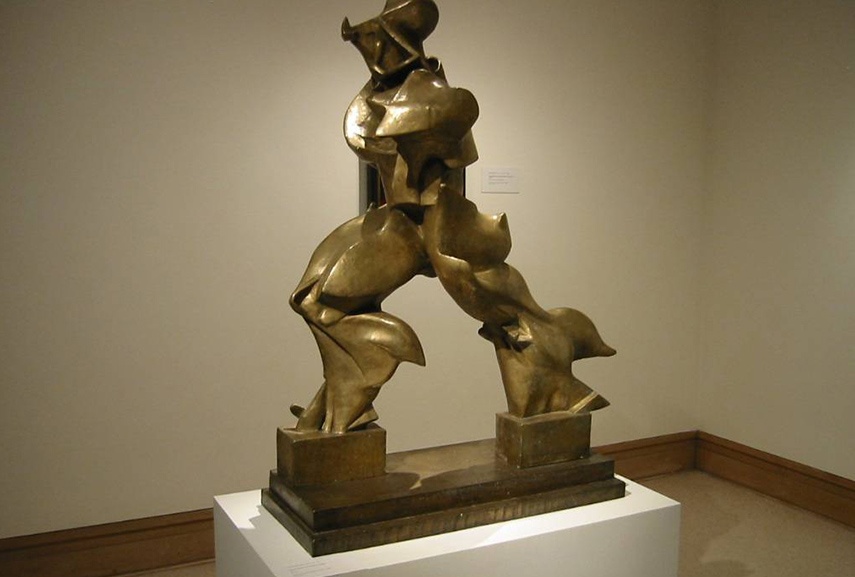
Negotiating Abstruse Art - Suprematism, Neoplasticism, Bauhaus
All of the movements from the 1900s and 1910s were gradually leading up to a total reduction of shape and class, which was officially crowned for the first time through the works of the Russian avant-garde. Those who were not inclined to affiliate art with life, like Constructivists did, joined Kazimir Maljevic and his concept of the "supremacy of the pure artistic feeling" over representation (embodied through Suprematism ). A like idea guided Mondrian when he explained the nature of Neoplasticism, or in a more "designerly" mode - De Stijl. The idea was to create a universal language, a linguistic communication without hidden meanings, a class of purism that is based on relations of shapes and 3 basic colors rather than "true delineation" that aims to imitate rather than tell. Many of the artists who were associated with De Stijl were also members of the Bauhaus schoolhouse, which was founded in 1919 and stood equally a representative of an all-encompassing mode that conjoined ideas from opposing styles, and aimed to merge intellectualized fine art with manufacture.

Dada - The Ultimate Avant-Garde Movement
Even today, we can safely say that Dada was the essence of the avant-garde, the pioneer of anti-art which inspired many of their successors and one of the almost radical responses to the political climate of the early 20th century. The group that used to get together in Cabaret Voltaire is basically responsible for the rapid change of grade in art. They were driven by the lack of correspondence between art and life, in which art was repetitively failing to address the disorder and chaos that people felt. In Dada, there were no rules, no rights or wrongs, "No more painters, no more than writers, no more religions, no more royalists, no more anarchists, no more than socialists, no more politics, no more airplanes, no more urinals... Like everything in life, Dada is useless, everything happens in a completely idiotic way... We are incapable of treating seriously any subject field whatsoever, let alone this subject: ourselves."[ii] Different art styles and movements, Dada was never constrained by anything, which is probably why the things that Duchamp, Tzara and their contemporaries did are still considered equally prodigious fifty-fifty when discipline to our 21st century gaze. In fact, the but matter that had a formulating touch on Dada was its eventual reception amidst the critics, which made the members terminate the motility. What was proclaimed non-art has eventually become art, and not ironically equally Duchamp may take intended at first. We will accept seen that Dada, in which everything is a piece of art, indirectly gave ascension to almost all avant-garde movements to come up and (unintentionally?) introduced a variety of new media.
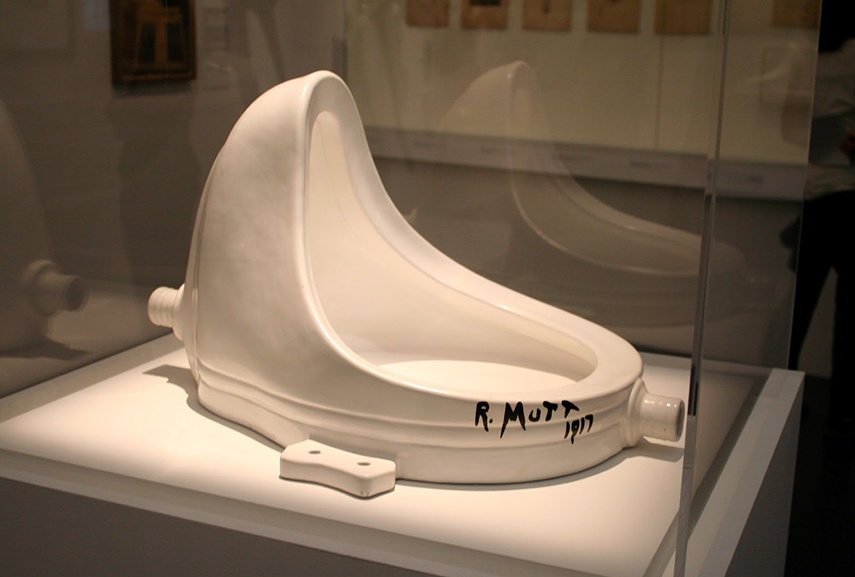
Surrealism
In the early 1920s, Surrealism appeared equally a stylistic successor of Metaphysical Art and in response to the Dadaist activities from the past. Both were implemented with the help of Andre Breton, who was part of the Dada movement himself and a dandy gentleman of de Chirico's work. While his automatic writing was conceived during the Dada catamenia, it is one of the precursors of Surrealism as a school that emphasizes the part of the unconscious in creative processes. Interestingly, Breton did not come to his beauteous leading position on his own. In 1924, two groups of Surrealist artists formed, each challenge to be the followers of Guillaume Apollinaire'due south revolution. After a series of debates and fights over who has the right over the term Surrealim, Breton turned out to exist more than eloquent and his group eventually outnumbered the one led by Yvan Goll. But even subsequently the move was established and divers by a manifesto, information technology was oft accompanied past disagreements and fractions.[three] Even so, that didn't prevent Surrealism from becoming one of the most influential movements, especially since information technology continued to exist even in the mail-state of war period. Scholars cite the year 1966 as the moment in which the movement, as an organized group, ended (it was the twelvemonth in which Breton died), however as a style in literature, painting and film, it connected to live on.
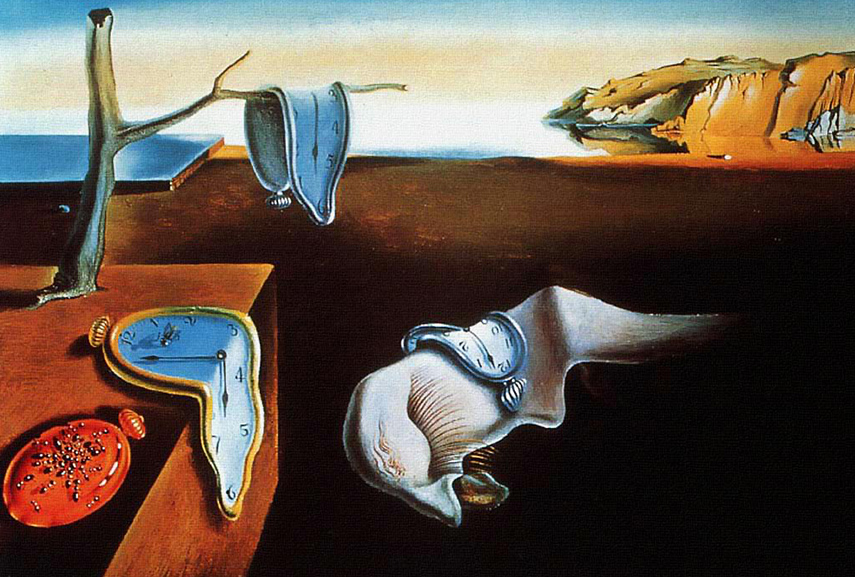
Abstract Expressionism
Briefly before and during the Second Globe State of war, many creatives moved from Europe and establish refuge in the U.s.a.. Incidentally, it was the menses in which Abstract Expressionism emerged in America. The war is ofttimes associated with this style, usually as an caption for the embodiment of anarchy plant in these paintings. The other reason for this is the flow of regression that was happening in Europe at the time, when Hitler and the Nazi Party proclaimed all types of non-traditional art "degenerate".[4] Every bit the proper name suggests, the fashion reflected inner emotion and self-expression, through non-figurative means that oft (just non exclusively) involved the trace of the author's torso movements or brush strokes. Although most of us automatically recall of Jackson Pollock and his dripping technique, Abstract Expressionism was more of a philosophy than a proper name for a unified visual identity. Still, it was the outset internationally acclaimed influential motility to originate in America.

Popular Art
But information technology certainly didn't cease there, because then came Pop Art. The ambiguous postmodern movement was a direct response to the over-intellectualized high fine art (Abstract Expressionism, that is). Surprisingly, this idea to merge low fine art and high art turned out to be a major success. Pop Art was the verbal reverse of what preceded it, as it involved highly figurative motives and objects from popular culture, speaking to the broader audiences in a more relatable, familiar language. It is yet one of the about distinct styles, and it became a highly collectible, commercial blazon of art that indeed was respected both by high art institutions and the masses.
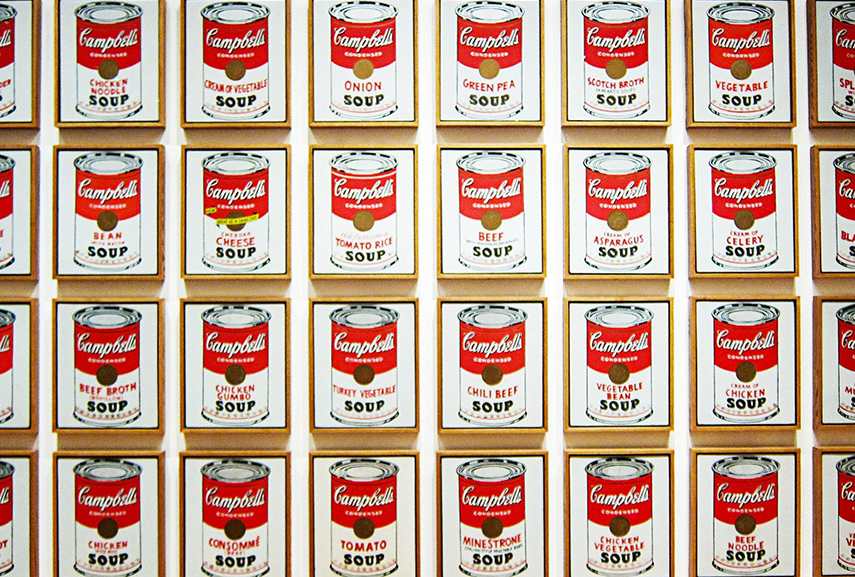
1960s - Protests, Revolutions and Conceptual Art
The 1960s and the early on 70s are frequently regarded as the decades of cultural and societal revolutions. In a non-chronological gild, let's only remind ourselves that this was the period in which many of the civil rights movements came into beingness, such as The Black Panther Party . It was also when Feminism started its offset serious accept on the fine art world, and when Street Art emerged on the streets of New York. Coincidentally, the 60s marked the emergence of Conceptual Art too. Greatly dependent on what was already done in the past (particularly, Dada and Duchamp), conceptual artists questioned an artist'due south need to produce annihilation material at all. They felt that the thought, or namely the concept backside a slice of art is more important than its aesthetic quality, or any other aspect of an artwork.[5] Since their goal was to negate aestheticism of any kind, artists such as Joseph Kosuth, Sol LeWitt, Robert Barry and the group Art & Language started using linguistic communication, text and diagrams as mediums. In this menstruation, the role of a gallery equally a formalist white cube was brought into question, as they were against art as commodification equally well.

Belatedly 20th Century Art and the 21st Century
Not-material fine art that favors the thought over the fabric product gave rise to Functioning and State Fine art. Fine art-making was no longer strictly related to galleries indeed, and many new types of non-art and anti-art appeared. Yet, what we know about art today tells us that galleries are still pretty much as white every bit ever, meaning that conceptual art was eventually silenced or transformed by the art market. Artworks are getting more expensive each day - fifty-fifty the ones produced by conceptual artists from the 60s - and the market just keeps on growing (while everything else seems to go downwards). Everything is a commodity, and the very reason why art is being produced is problematized now more than e'er. Ethics and art production seem to clash on a daily basis.
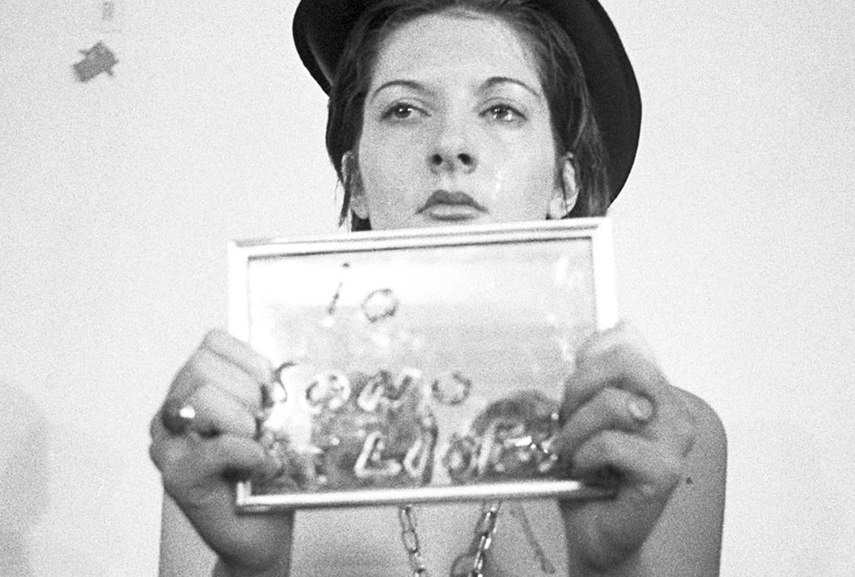
Contemporary Art, Post-Conceptual Art
In the final decades of the 20th century, the term Contemporary Art came into use, in order to attempt to classify dissimilar types of art that coexist at the same time. Not the best option of words, since it is still used only like it was 30 years ago, to define art that is contemporary, meaning - in relation with the time in which it is fabricated. The confusing term contributes to the fragmentation of all the various types of artworks nosotros can run into in the 21st century. For this reason, Peter Osborne uses the term post-conceptual rather than gimmicky to define creative practices that are predominant today (although he does brand a distinction between the 2).[half-dozen] These works seem to resonate with the thought that the concept is a crucial part of fine art, merely it is, still, acknowledged that the aesthetic aspect is its integral part, even if redundant. Nonetheless, this doesn't come beyond every bit a consequent style or a movement. What nosotros might demand today is something equivalent to Dada. Well, at least the state of the globe seems only every bit chaotic today equally it did in 1915.
References:

Editors' Tip: The 20th Century Art Book
Complementing the phenomenally successful Art Book, and most recently The American Art Volume, The 20th Century Art Book presents a new and original way of bringing art live. The book comprehensively covers the international nature of the modern art scene, encompassing the established, iconic artworks and the classics of the hereafter. There are around 500 artists showcased in alphabetical order, each represented by an illustration and a text that gives valuable information both about the slice and the author. This book is above all like shooting fish in a barrel to use: cross-references help the reader make connections between artists; in that location is a jargon-free glossary of artistic terms and movements; and an international directory of museums and galleries lists the works on public view.
Featured images: Constantin Brancusi - Newborn, via Huffington Post; Carl Andre, Robert Barry, Douglas Huebler, Joseph Kosuth, Sol LeWitt, Robert Morris, Lawrence Weiner - The Xerox Book; Works past Alberto Giacommeti; Roy Lichtenstein - The Ring, 1962. All images used for illustrative purposes only.
Source: https://www.widewalls.ch/magazine/20th-century-art
0 Response to "Isms Understanding Modern Art on Early 20th Century Art"
Post a Comment